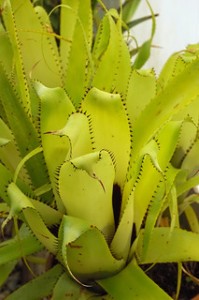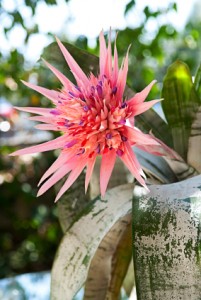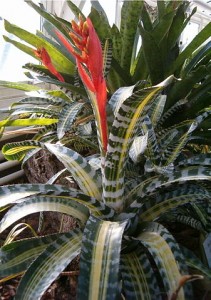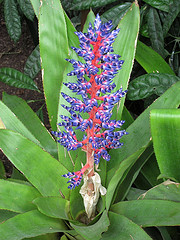Aechmea: The Beginner’s Bromeliad
Author: Melanie Dearringer23 Comments
Care and Culture, Classification

It is easy to become attracted to the exceptional beauty of bromeliads. If you have found yourself drawn to these plants and would like to try growing one of your own, the Aechmea (pronounced EEK-me-uh) genus may be a good place to start. Aechmea is a genus of plants found in the Bromeliaceae family. Aechmea gets its name from a Greek word meaning “spear tip”.

-The spiny margins of Aechmea triangularis
Many Aechmeas have sharp spines along the margins or outer edges of their leaves. The Aechmea genus contains 255 different species that originate from throughout Central and South America. Some have adapted for growth in moist, shady forests while others prefer more arid regions. Aechmea broemliads offer a great variety in color, foliage, and growth habits. They are especially easy to care for and reward their owners with bright, long lasting inflorescence.
Most Aechmeas are epiphytic meaning they grow non-parasitically on another host such as a tree. However, they are often sold as potted, terrestrial plants in nurseries and flower shops. While they can grow well in pots, their root systems are not large. In the wild, Aechmea’s roots merely act as an anchor attaching the bromeliad to the host plant. They take in water from rainfall and nutrients from dust, insects, and other particles that have collected in their tanks. It is common for Aechmeas to become top heavy. Their foliage is large and meaty yet their small root systems prefer small 4-6 inch pots.
General Care
Most Aechmea are well suited to grow both indoors or outdoors. They thrive in light shade or indirect sunlight. Aechmeas can flourish in indoor office spaces. The florescent lighting will typically be enough to satisfy this bromeliad. They can be grown outdoors in climates that have no risk of frost. They are susceptible to few pests and are more unlikely to succumb to insect related illness or disease than other indoor plants.
Watering
Aechmea’s foliage grows without a stem. The leaves grow together forming a rosette shape at the center of the plant. It takes in water through this rosette, which is more commonly referred to as a tank. The Aechmea’s ability to store up water in its tank to be used as needed helps it to survive through periods of sporadic rainfall. When caring for an Aechmea in your home, it is important to keep water in its central tank at all times. Be sure to flush this water regularly. Water left to stagnate in the tank can lead to bacterial infection, pests, and build up of salinity that can eventually lead to plant damage. You should empty the tank and rinse your bromeliad at least once a month. Do this more often if you notice build up on the leaves. Filling the tanks with distilled water or rain water will help prevent the build up of salts commonly found in tap water.
A Clear Favorite
Aechmea fasciata

-Aechmea fasciata
Aechmea fasciata, more commonly known as the urn plant, is one of the most widely recognized species in the Aechmea genus. This bromeliad has thick, broad leaves.They are green in color with a silvery, horizontal banding. The flower spike is composed of bright pink bracts that can display for several months. Small purple flowers appear from the bracts when in bloom. Urn plants will thrive in almost any indoor environment with little attention. The simply need clean water in their tank and bright, indirect light.
While the urn plant is beautiful, easy, and rewarding. There are many other species and cultivars of Aechmea that a first time bromeliad grower can experiment with. Once you are comfortable growing Aechmea fasciata you may want to consider trying your hand at one of these more unique bromeliads.
Other Effortless Aechmeas
Aechmea chantinii

-Aechmea chantinii
Aechmea chantinii, better known as the Amazonian Zebra Plant, is another common bromeliad grown indoors. It has large dark green leaves with lighter yellow vertical stripes and white to silvery horizontal stripes. The Amazonian Zebra Plant can grow to be 2-3 feet across and 1-3 feet tall. Its flower spike has red or orange bracts with tight red flowers.
Aechmea fosteriana
Aechmea fosteriana, also known as Foster’s Favorite Aechmea or Lacquered Wine Cup, is also a lovely Aechmea species. There are several different cultivars of Foster’s Favorite. Some have dark green leaves with a shiny, glossed appearance. Others are a deep purple, almost black, throughout the leaves. The bracts are a deep red or wine color. Foster’s Favorite can grow up to 18 inches tall and 18 inches wide. The flower spike is pendant shaped, curving down around the sides of the plant. It produces a red or red and blue tip flower. Foster’s Favorite can handle light shade but will thrive in bright, indirect sunlight.
Del Mar

-Aechmea Del Mar
The Del Mar cultivar has bright light green leaves that are broad and leathery. The leaves are surrounded by small but very sharp spines. The most stunning characteristic of the Del Mar is its flower spike. The flower spike itself is hot pink rising above the foliage in the middle. On the end of the flower spike are brilliant bluish-purple bracts. This cultivar grows to about a foot high and thrives in light shade.
There are many more beautiful and unique varieties of Aechmea. Aechmeas make excellent gifts and can be easily found in decorative containers at florists, nurseries, and garden centers. Their minimal care requirements make them an ideal plant for the beginner bromeliad grower. The Aechmea will reward you with a beautiful, long-lasting flower spike and truly unique foliage.
Which bromeliad did you start with?
Sources
Plant Files. “Dave’s Garden.” <http://davesgarden.com/guides/pf/>
Bromeliad Encyclopedia. “Florida Council of Bromeliad Societies” <http://fcbs.org/>
Lacquered Wine Cup. “Desert-Tropicals” <http://www.desert-tropicals.com/Plants/Bromeliaceae/Aechmea_fosteriana.html>
“Bromeliad Society International” <http://www.bsi.org/>
Aechmea chantinii photo credit: BotBIn via http://en.wikipedia.org/wiki/File:Aechmea_chantinii_Variegata_BotGardBln1105a.jpg
Aechmea Del Mar photo credit: Bosc d’Anjou via http://www.flickr.com/photos/boscdanjou/7270591998/
Aechmea fasciata featured photo credit: ecos de pedra via http://www.flickr.com/photos/ecosdepedra/406669149/
Aechmea triangularis photo credit: Eric Hunt via http://www.flickr.com/photos/ericinsf/218184331/
23 Responses to “Aechmea: The Beginner’s Bromeliad”
Leave a Reply

Resource Download
Hechtia Care Cheat Sheet
Learn how to care for your Hechtia bromeliad with this quick and easy informational guide.
Learn More
Ask an Expert
Questions about bromeliads?
Our experts love a challenge!
Photo of the Week
Submit your photo to be featured on the blog!
More Photo of the Week Winners
Submit Photo








I really need help with my AECHMEA FASCIATA, i have had it for several years but it hasn’t flowered for the last 3. It is getting crowded in it’s pot (I’m separating plants and repotting it tomorrow) but other than that i don’t think anything is wrong. Any ideas?
ALMOST ALL BROMELIADS ARE MONOCARPIC, I.E. ONCE THEY HAVE FLOWERED, THEY WON’T FLOWER AGAIN. THE MOTHER PLANT WILL SLOWLY DIE, BUT ALONG THE WAY IT WILL PRODUCE OFFSETS KNOWN AS ‘PUPS’. If your plant flowered when you first had it, it won’t flower again. You can keep separating off the pups and potting them up as long as the mother keeps producing them. They can be grown on and are capable of flowering, but eventually the original plant will just die off.
Sorry about the caps – the website isn’t allowing me any other option.
Place a small piece of apple in each cup you’d like to see bloom. Place a clear plastic bag over the entire plant. The ethylene gas from the apple will encourage blooming. Good luck!
Can I trim off the outer leaves without hurting the plant; and when is a good time to do it?
Mine keep on flowering annually
I have the aechmea primera, my fiance gave this to me for mothers day. I was very delighted and excited as I had never seen or heard of these plants before they are so beautiful and unique. I am in love and hope to get more of these plants your advice was very helpful thank you so much I hope I do well with this plant
The flower rotted at the base of the stem and I pulled it out. Will it grow again? Was this due to too much water?
Like wendy our flower rotted at base and has been removed. since then we have noticed 4 shoots growing from around the base. what should we do with these?
You can regrow the shoots in the “new” plants this is the life cycle of the bromeliads
I had the same issue with the flower rotting at the base and I pulled it out. I had a pup to re-pot at the time but once I pulled the plant out of the dirt I realized I had no idea what I was doing! How much of the white base of the main plant do I break off with the pup? I’ll have to wait for more pups to do with again since it sounds like this one won’t be flowering again and the pup I took off previously is dead as can be. Help! I really liked this plant!
The main plant is on its way out, but new pups will still grow out of it. Cut the pup off at the stem and pot it. You can get many new plants from the main plant.
Just got the aechmea . In reading description of care I’m reading about putting plant in a tank and flushing. What does any of this mean?
The tank actually refers to the central “cup” or “tank” of the bromeliad plant, not an actual tank of water. Some bromeliads have a center area that holds water and this can sometimes become stagnant and need cleaning/flushing out.
I was just given one of these plants. How do you flush out the tank?
I have just been bought the “Blue Rain”. How beautiful. Never seen them before and your advice on here will be tremendous help for my future care of it. I like to research so I don’t kill my plants. Thanks.
What kind of soil do you suggest for the pups growing? I need to separate mine and I guess toss the mother plant? I’ve never done this before but since the mother plant is looking deader each day and the pups greener each day, I need to do something. Tips on replanting? Tips on removing the pups?
Repot the pups when they are 1/3 the size of the mother. Here’s our pup guide: https://www.bromeliads.info/files/beginners-guide-bromeliad-pups/
how do you handle these? the leaves have a serrated edge, and the dry blooms have cactus-like spines that really hurt and are so tiny as to be hard to remove from my skin!
Leather gloves work great!
The flower bloom is drying up. Is there a way to remove it without harming the plant?
Hi Sharon, Yes, you can cut off the bloom toward the base of the plant with a sterile blade.
I love my plant had it for 6 months problem bottom leaves are turning yellow to brown now loosing 4 more what can I do?
i have rather a question: I bought an Aechmea – in a pot – I would like to plant it out in the garden – now I read it is an epiphytic – so what should I do?